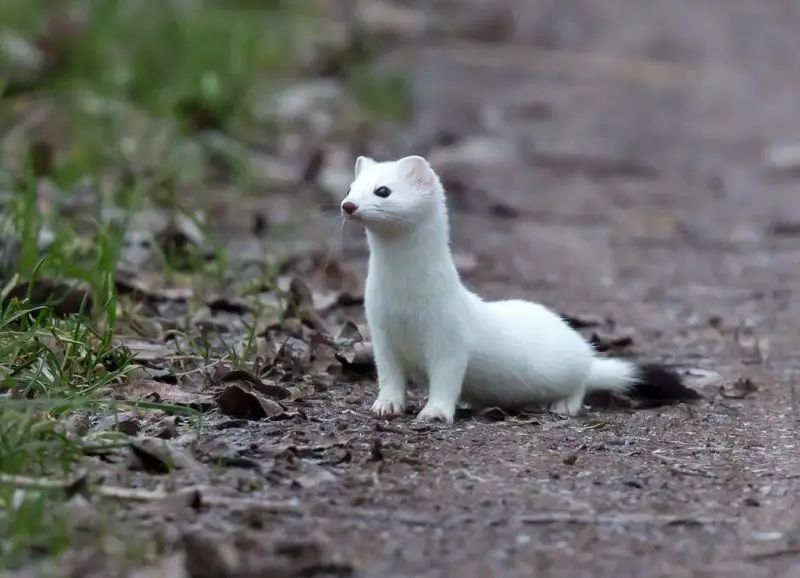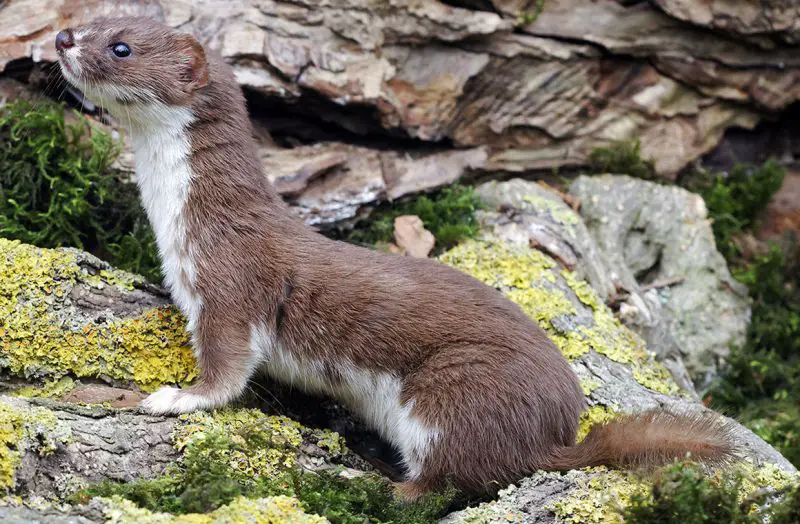Ohio’s landscape, spanning dense forests and open fields, provides a variety of ecosystems that serve as suitable habitats for the weasel family, or Mustelidae. These small carnivores are admired for their agility, hunting skills, and adaptability. They are key predators in Ohio’s ecosystems, playing an essential role in controlling populations of small mammals.
Among Ohio’s weasel species, three stand out as the most commonly observed: the Long-tailed Weasel (Neogale frenata), the Short-tailed Weasel or Ermine (Mustela erminea), and the Least Weasel (Mustela nivalis). Each species has unique physical characteristics, behaviors, and ecological roles, making them fascinating to study and identify in the wild.
Studying these species provides insight into Ohio’s ecological balance, predator-prey interactions, and seasonal adaptations. Observing weasels in their natural habitats also allows wildlife enthusiasts to understand their hunting, mating, and territorial behaviors, which vary by species and season.
Long-tailed Weasel: The Agile Predator

Identification and Physical Characteristics
The Long-tailed Weasel is easily recognized by its elongated, slender body, which measures between 8 to 10 inches in length, with a tail constituting nearly half of its total body length. Its fur is brown on the upperparts with a yellowish-white underbelly during warmer months. In winter, its coat may turn almost entirely white, except for the black tip on the tail, a signature feature that distinguishes it from other weasel species. Its sharp, pointed snout, small rounded ears, and bright dark eyes contribute to its keen sensory abilities.
Adult males are slightly larger than females, and their size allows them to hunt larger prey, such as rabbits, while smaller females primarily focus on mice and voles. This sexual dimorphism affects not only hunting efficiency but also territorial behavior, as males maintain larger hunting ranges. The Long-tailed Weasel’s body shape and fur coloration provide exceptional camouflage in both forested and open field habitats, allowing it to move stealthily while hunting.
Habitat and Distribution
In Ohio, Long-tailed Weasels occupy a wide range of habitats, including dense forests, brushy fields, farmlands, and riverbanks. They prefer areas with thick vegetation or undergrowth, which provides cover for hunting and denning. These weasels are highly adaptable and can live near human settlements, particularly in rural areas where small mammals are plentiful.
Their distribution is widespread across Ohio, though sightings can be rare due to their elusive nature. They often use abandoned burrows from other animals, such as rabbits or groundhogs, as dens. These dens are strategically located near food sources and often contain multiple entrances for quick escape from predators. Seasonal habitat shifts occur depending on prey availability, with some individuals moving into more open fields during the winter months.
Behavior and Hunting Techniques
Long-tailed Weasels are active year-round, displaying remarkable agility and hunting skill. They primarily prey on small mammals such as voles, mice, shrews, and rabbits but will also consume birds, eggs, insects, and occasionally amphibians. Their hunting style involves stalking prey silently and launching rapid, precise attacks. They are capable of chasing prey into burrows, using their slender bodies to navigate tight spaces.
These weasels are solitary and territorial, marking their ranges with scent glands. Their high metabolic rate demands frequent feeding, and they often cache surplus prey for later consumption. Long-tailed Weasels are known to be nocturnal or crepuscular, but in areas with low human disturbance, they can also be observed during daylight hours. Seasonal changes, such as snow cover in winter, influence their hunting patterns, as the white winter coat offers concealment while stalking prey.
Reproduction and Life Cycle
Mating occurs in the summer, but the fertilized egg undergoes delayed implantation, which allows birth to occur in spring when environmental conditions are optimal. Gestation ranges from 205 to 337 days due to this delay. Litters generally consist of 4 to 8 kits, born blind and entirely dependent on the mother.
The kits remain in the den for several weeks before beginning to explore their surroundings. Mothers teach their young essential survival skills, including hunting techniques and how to navigate the terrain. By late summer, juveniles are capable of independent hunting, gradually establishing their own territories. Survival rates of juveniles are influenced by prey abundance and predation pressure from larger mammals and birds of prey.
Best Time and Place to Observe
The best time to observe Long-tailed Weasels in Ohio is during early spring and late fall, when they are most active and fur patterns contrast with their surroundings. Areas with dense brush near streams, forest edges, and farmlands are ideal for spotting these elusive predators. Patience and quiet observation are key, as they are cautious and tend to avoid human contact.
Short-tailed Weasel (Ermine): The Winter Cloak

Identification and Physical Characteristics
The Short-tailed Weasel, commonly called the Ermine, is smaller than the Long-tailed Weasel, typically measuring 7 to 8 inches in body length with a proportionally short tail. Its fur is brown during summer, turning entirely white in winter, except for the black tail tip, which serves as a visual cue for predators and fellow weasels. This seasonal color change provides excellent camouflage in snowy environments, allowing the ermine to hunt and hide efficiently.
Ermines have a slender body with a pointed snout, rounded ears, and sharp teeth adapted for catching small prey. Their lightweight frame enables them to move quickly and with agility, especially in dense underbrush or snow. Females are slightly smaller than males and often remain closer to secure cover while rearing young. Their fur’s transformation is one of the most striking adaptations among Ohio mammals, aiding survival in harsh winter conditions.
Habitat and Distribution
Short-tailed Weasels inhabit diverse environments in Ohio, including open woodlands, grasslands, wetlands, and farmlands. They are highly adaptable, thriving in areas that provide dense vegetation or ground cover where prey populations are high. Their distribution spans most of the state, but they are most abundant in habitats that combine shelter with easy access to small rodents.
Dens are usually constructed in burrows, rock crevices, or hollow logs. These secure retreats provide protection from larger predators and harsh weather. During winter, the Ermine may shift habitats to areas with deeper snow, which provides insulation and camouflage while hunting.
Behavior and Hunting Techniques
Short-tailed Weasels are aggressive and efficient predators, feeding primarily on voles, mice, shrews, and occasionally young rabbits or birds. Their hunting strategy involves stealthy stalking, sudden bursts of speed, and using their slender bodies to chase prey into tight spaces. They are capable of killing prey larger than themselves due to their powerful bite and high energy levels.
Ermines are solitary and highly territorial, marking their ranges with scent. They are active both day and night, but activity peaks during dawn and dusk. Food caching is common, as they store small prey items in dens or hidden locations for times when hunting is less successful. Seasonal variations influence their hunting patterns, with snow cover offering protection from larger predators while providing concealment for stalking prey.
Reproduction and Life Cycle
Mating occurs in late spring or early summer, with delayed implantation similar to Long-tailed Weasels. Gestation ensures kits are born in optimal spring conditions. Litters range from 4 to 9 young, born blind and fully dependent on the mother. Mothers teach kits essential skills, including hunting, navigating terrain, and avoiding predators. Juveniles disperse during late summer or early fall, establishing their own territories for the next breeding cycle.
Best Time and Place to Observe
The optimal time to observe Short-tailed Weasels is in late winter and early spring, when white winter coats contrast against remaining snow patches. Ideal locations include forest edges, wetlands, and dense brush near open fields. Observing from a concealed vantage point increases the likelihood of sighting these cautious predators.
Least Weasel: The Tiny Dynamo

Identification and Physical Characteristics
The Least Weasel is the smallest carnivore in the world, with adult males measuring 6 to 8 inches and females slightly smaller. Their fur is brown on the upperparts with a white underbelly during summer, turning entirely white in winter. Unlike other weasels, they do not have a black tail tip.
Despite their diminutive size, Least Weasels are fierce and highly energetic hunters. Their compact body, sharp teeth, and pointed snout allow them to pursue and kill prey much larger than themselves. These adaptations make them effective predators of mice, voles, and shrews.
Habitat and Distribution
Least Weasels are primarily found in open areas such as meadows, marshes, brushy fields, and agricultural lands in Ohio. They favor habitats that provide both cover and abundant prey. Their distribution is somewhat patchy, as they are dependent on areas with sufficient rodent populations and adequate vegetation for shelter.
Dens are often shallow burrows or abandoned rodent tunnels. Least Weasels rarely venture far from these dens, which provide safety from predators such as owls, hawks, and larger mammals. Seasonal movement is minimal, but they may adjust hunting locations based on prey availability.
Behavior and Hunting Techniques
The Least Weasel has an extremely high metabolic rate, requiring it to consume up to half of its body weight daily. They primarily hunt small rodents using stealth, speed, and precision. Despite their tiny size, they are capable of taking down prey larger than themselves through rapid, repeated attacks.
Least Weasels are solitary and highly territorial, marking their areas with scent glands. Their activity is both diurnal and nocturnal, with peaks during early morning and evening hours. Food caching is less common than in larger weasel species due to their small size and constant need to feed.
Reproduction and Life Cycle
Breeding occurs in the spring and late summer, producing multiple litters per year. Litters typically consist of 4 to 5 young, born blind and helpless. The mother provides warmth, food, and protection until the kits are able to hunt and survive independently, usually within a few months. High predation risk and the need for frequent feeding make early survival challenging for juveniles.
Best Time and Place to Observe
The best time to see Least Weasels is during spring and fall when prey activity is highest. Ideal observation locations include meadows, agricultural fields, and areas with dense ground cover. They are highly elusive, so spotting them often requires patience, quiet movement, and careful observation near rodent burrows.
Interactions with Humans
Weasels are generally not aggressive toward humans but may occasionally enter poultry farms or gardens in search of food. They are beneficial in controlling rodent populations, making them valuable allies for farmers. Observing weasels in their natural habitats provides insight into their behavior without causing disturbance. Conservation of hedgerows, forests, and brushy areas supports their populations and contributes to healthy ecosystems.
Conclusion
Ohio’s three primary weasel species—the Long-tailed Weasel, Short-tailed Weasel, and Least Weasel—demonstrate remarkable adaptability, hunting prowess, and ecological importance. Each species exhibits unique physical traits, behaviors, and seasonal adaptations that allow them to thrive in diverse habitats. Understanding these elusive carnivores enhances our appreciation for Ohio’s wildlife and emphasizes the importance of preserving their natural habitats for future generations.
With patience and careful observation, wildlife enthusiasts can witness these agile predators in action, gaining insight into the delicate balance of predator and prey within Ohio’s ecosystems.
FAQs About Weasels in Ohio
What types of weasels live in Ohio?
Ohio is home to three main species of weasels: the Long-tailed Weasel (Neogale frenata), the Short-tailed Weasel or Ermine (Mustela erminea), and the Least Weasel (Mustela nivalis). Each species has unique characteristics, behaviors, and habitat preferences.
How can I identify a Long-tailed Weasel?
Long-tailed Weasels have an elongated, slender body, brown fur with a yellowish-white underbelly in summer, and a black-tipped tail. They are larger than Short-tailed and Least Weasels and are very agile predators.
When are weasels most active?
Weasels are mostly nocturnal or crepuscular, meaning they are active during dawn and dusk. However, in areas with little human disturbance, they can also be seen during the day, especially in spring and fall.
What do weasels eat in Ohio?
Weasels are carnivorous and primarily feed on small mammals such as mice, voles, shrews, and young rabbits. They may also eat birds, eggs, insects, and occasionally amphibians.
Where can I see weasels in Ohio?
The best places to observe weasels are forest edges, brushy fields, farmlands, wetlands, and areas with dense vegetation. Patience and quiet observation are essential since these animals are very elusive.
How do weasels reproduce?
Weasels have delayed implantation, meaning fertilized eggs develop slowly so that young are born in favorable conditions. Litters typically consist of 4 to 9 kits, which are born blind and fully dependent on their mother.
Are weasels dangerous to humans?
Weasels are generally not aggressive toward humans and tend to avoid contact. They can, however, enter poultry farms or gardens in search of food but are more beneficial than harmful due to their role in controlling rodent populations.
Do weasels hibernate in winter?
No, weasels do not hibernate. Instead, they remain active year-round, adjusting their hunting techniques and habitats to cope with winter conditions, often using snow cover for camouflage.
What is the difference between Short-tailed and Long-tailed Weasels?
The Short-tailed Weasel is smaller, with a shorter tail and seasonal fur changes that turn completely white in winter except for the black tail tip. Long-tailed Weasels are larger and retain a longer black-tipped tail year-round.
Why are Least Weasels considered fierce predators despite their small size?
Least Weasels have a high metabolism and exceptional agility, allowing them to hunt prey much larger than themselves. They consume up to half their body weight daily and are capable of rapid, precise attacks on small rodents.






